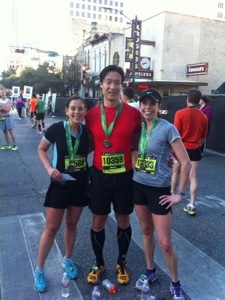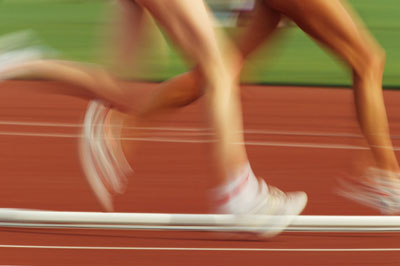My friend Jason and I were talking about running and Jason mentioned that his friend, Chinh, was trying to increase his cadence (stride turnover) to improve his running times. Interesting. I know that many people try different things to improve their pace/times. Personally, I’ve found that running intervals (quick pick ups) has helped me to improve my pace and comfort while running faster. I also like running short races – like 5Ks- to include more speedwork (read: I am too lazy to really do speedwork!) and running with people who are faster than me to improve speed.

I did an informal poll of my “experts” – my TTAU teammates, Kindrunner ambassadors, members of the “Bootleg Runners Coalition” and Chicago Running Bloggers to ask if anyone had tried to change/improve cadence to improve their running times. My question: Hey all – I am writing a not scientific blog post on improving speed in running. A friend suggested he was trying to change his cadence to improve speed. Has anyone tried to improve their speed with change in form or cadence? If not – what have you done or tried?
Cadence bubbles up for many respondents:
- My TTAU teammate Sean is a personal trainer. He says, “Speed is simple: stride length x frequency. You can improve one or the other to get faster. Things to improve stride length include: fascial release and flexibility.“
- My TTAU teammate Robert (a/k/a “Rabbit”) just ran a 2:38 marathon in Boston. He has a pretty compelling story about changing his cadence- which he allowed me to share:
“Back in 2005/2006, when I was a beginner to running, I was inexperienced and had just gutted out a couple of marathons in the 3:15-3:30. Not bad for a rube. I improved a little with some basic mileage underneath me, but was still only a so-so runner.
A coach told me that I had a good stride, but I wasn’t efficient enough. If I upped my cadence from roughly 83-85 steps per minute to 90 steps per minute, then I would not only increase my efficiency but I would also reduce my risk of injury. This was going to be key if I wanted to take my running to the next level (ie, qualify for Boston, get faster from there, and eventually keep running longer-term).
Generally speaking, when you have a lower cadence, you heel strike. This is akin to slamming on the breaks with every single step. It sends shock waves up your legs into your knees and hips. It will lead to injury. You can either mitigate that with expensive shoes and trips to doctors to get inserts, or you can fix it yourself by learning to strike properly: faster and underneath your hips. Just think of how often you heel strike when running barefoot… never, and you do it pretty darn quickly.
The mathematics behind this also makes sense: Maximize the steps per span of time + maximize the length per stride, and you’ll be faster. There’s a nice equilibrium to reach for: your body won’t allow you to over stride and maximize steps at the same time.
After working on this throughout my next training season, I was able to get my cadence up to about 88-89. My marathon that fall was a breeze at 2:58.
Years later, I’m 2:38 and my cadence is about 92 steps per minute, regardless of pace. It doesn’t matter if I’m running a 8 minute mile or a 5 minute mile… it’s freakish that I’m always around 92. Aside from some standard aches and pains from over-usage, I have been injury free for the last several years. I have no doubt that increasing cadence is one of the easiest and best things that someone can do to improve their running.
SO – the quick fix: count the number of times that your left foot strikes the ground in one minute. Try to speed that up to about 90 strikes. Elites generally hit about 92-94 a minute. It’ll take time and a lot of practice, but it will absolutely yield results. Thousands of miles later, I still check myself at least once on almost ever single run. That same coach told me that “strong form will carry me through a race”. Anytime I ever feel myself fading, I check my cadence.”
You can check out Robert’s blog HERE. He seems to keep getting faster and faster, so he is on to something for sure!
Many of my respondents agree with Sean and Robert, too:
- Patrick Jacobs from Kindrunner says: “As far as through form or cadence drills, I can tell you through experience that changing your foot strike from heel to midfoot will help your top end speed. Increasing cadence does help with top end speed as well. The key to sprinting is to avoid overstriding while increasing cadence.“
- Chicago Running Blogger, Cary says, “It worked for me! It wasn’t specifically for the purpose of improving speed, but it was actually part of my physical therapy regimen for my knee. My PT suggested I start running to PodRunner, which focuses on bpm/strides per minute. Since then, my speed has improved significantly!“
- Other Chicago Running Bloggers weighed in, too:
- Emily says, “I used to be a heel striker but I’ve worked on becoming a midfoot striker. I also used to “overstride” but I’ve worked on shortening my stride so that my footstrike occurs in line with the hip. Both these tactics were also based upon PT regimens for me, same as Cary. Additionally, I’ve tried wearing more minimalistic shoes as I’ve heard they help encourage correct form. I think all of these tactics have helped a little bit. But unfortunately I wouldn’t say I’ve noticed huge changes as the result of any. My natural cadence is already pretty close to the 180 BPM, so I didn’t try altering that.“
- Kelly says, “I do the drills prescribed by the POSE method and that seems to help.“
- Marcia says, “When I started learning ChiRunning I worked on increasing my cadence and definitely got faster.“
- Colin from the “Bootleg Runners Coalition” says, “I made a change to my cadence and form (primarily after reading Born to Run) and my speed improved. I focused on higher leg turnover with shorter stride lengths and a slight lean-forward, instead of running so upright. However, this was in Year 2 of my running career so my speed improvement may have very well been incidental to my form change and more due to just to following the typical beginning runner’s speed improvement curve.“
What is Cadence?
Also known as stride turnover, a runner’s cadence is the number of steps taken per minute while running. Faster and more efficient runners have a cadence of around 180 steps per minute. To check your stride rate, go out for a run. Get into your natural running rhythm, then time yourself for 60 seconds as you count your strides. For ease, simply count each time your right (or left) foot hits the ground, then multiply by two.
I did some testing on a treadmill at my gym and I found that I am consistently 180 BPM or 90 steps/minute on one leg at a variety of paces. I need to check outside and see how I do. I also need to see how I feel when I get tired out! And do some counting then.
How Can I Improve My Cadence?
Here’s a drill from Running at about.com to help improve your stride turnover: “Start by running at about your 5K pace for 30 seconds and counting every time your right foot hits the ground. Then jog for a minute to recover and run for 30 seconds again, this time trying to increase the count by one. Repeat this several times, and try to add another step each time.As you’re trying to increase your turnover rate, focus on taking quick, light steps. Pick your feet up as soon they hit the ground, as if you’re stepping on hot coals. Your feet should be landing under your hips, not in front of you.”
Jeff Galloway recommends this turnover drill (and more) in this 1998 RW article:
1. Warm up by jogging slowly for half a mile.
2. Now begin to run at your normal training pace. After you’ve got your momentum going, start your watch. For exactly 1 minute, count the number of times your right foot pushes off. Then multiply that number by two. This is your current turnover rate.
3. Jog slowly back to the start.
4. Repeat step 2, and try to increase the number of right-foot push-offs per minute by two to five. Follow up with another recovery jog.
5. Do two to four more repeats, continuing to increase your push-offs each time until you’re not running comfortably anymore. Back off the cadence at that point, and for any remaining repeats, maintain the number of push-offs that allows you to stay relaxed while still using a faster turnover.
Also see: Running Songs at 180 BPM. Sync your tunes with your run and try to get moving at 180 BPM. Cary recommended PodRunner and Jason’s friend, Chinh, is planning to check out the ProMetronome app. AudioStep looks cool, too.
Here are some additional cadence resources:
- Increase your stride rate (Runner’s World)
- How to boost your cadence (Runner’s World)
- The Great Cadence Debate (Runner’s World)
- Efficient Running Tips from Hillseeker Fitness (video)
Other friends (and I) have other things that work for them:
- For me: doing intervals and speedwork and running with faster people (and more races) always helps me speed up or feel more comfortable running at a faster pace.
- From Ken – Speed change: “I did change shoes to help with my form. I started running almost all of my runs in racing flats. I feel it helped with faster turn over and forefoot striking. But the biggest thing was changing my diet. [His now wife] Christy got me eating really healthy. Breakfast became salads and maybe an egg and mostly vegetarian super foods for dinner (i.e.: kale, quinoa, squash, etc…) I dropped to the lightest I had been since high school (just before 2:57 PR at NYC I was down to 163 – lightest I had been for previous marathons was 168). I just had more energy and felt springier! Finally, run more and with faster people. Almost as much a factor as tweaking diet.”
- Other Kindrunner ambassadors suggest: boot camp (it improved my time and I did less runs), strength training plus a strong core really helps on the hills, speedwork and tempo, downhill running for turnover and pace, tabata style workouts, switch to Vibrams/change stride and focus on mid foot strike (change form to increase leg turnover)
Have you tried increasing your speed? What was the trick for you?
PS. Don’t forget to check out and enter my Summer Running Helpers giveaway!


